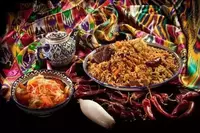The kazakh

In our country, Kazakh cuisine is considered the youngest, due to the fact that it began to take shape only in the late 19th - early 20th centuries and finally took shape when the Kazakhs switched to a settled position, and the economy of Kazakhstan changed radically.
The cuisine of Kazakhs for a long time was built exclusively on the consumption of meat and milk. The assortment of Kazakh cuisine was limited to horse meat and lamb, while the main types of milk were mare, cow, sheep or camel. It is clear that even with the most sophisticated fantasy of one milk and meat, it was difficult to come up with a wide variety of dishes, especially with the extreme limitations of grain and vegetable food raw materials.
Kumys and other types of fermented milk products were prepared in leather bags, and meat was cooked in leather sabers and wooden buds, lowering warmed stones there for heat. This is why soups were absent in the diet in the old cuisine of Kazakhs. Cast iron cauldrons as the main type of kitchen utensils appeared only in the 18th century, and with them some fried meat dishes began to be prepared.
The development of cooking in Kazakhstan went in such a direction as to develop meat and dairy semi-finished products that could be stored for a long time in conditions of constant nomadic life. So the Kazakhs came to the manufacture of smoked, smoked-boiled and salted-smoked semi-finished products from different parts of horse meat, fried condoms from sheep meat and lamb liver.
As a result, by the beginning of the 20th century, a characteristic feature of this cuisine developed, where meat and flour products dominated. The combination of meat and flour became the basis of classic recipes for Kazakh cuisine. A striking example is the national kushanya "et" and "beshbarmak. " At the same time, the use of various dairy products, which were mainly processed from horse and sheep milk - kumys, ayran, kurta, irimshika and sarsa - slightly receded into the background.
Another characteristic feature of Kazakh cuisine is the widespread use of offal, as well as their combinations with meat. By the way, horse meat is considered to be a national type of meat among representatives of Kazakhstan, although at present it is consumed less and less often, preferring lamb. But it is from horse meat that such national dishes characteristic of this cuisine are prepared as "kart'a, " "Kazakh, " "shuzhuk" and others.
To say that the traditional festive lunch in Kazakhstan is peculiar is not to say anything. It begins with kumys, followed by tea with cream, sweet snacks to which serve dried cottage cheese, nuts, raisins and "baursaki" (small balls made from fried pastry). A variety of horse and lamb snacks are then served, accompanied by a dish called "kuyrdak" (made from lamb leaver fat roast). . . Samsa or pies with meat and then "et, " that is, boiled lamb or horse meat, which is cut into thin slices and served with thick wide noodles, combined with a rich bulk broth. This dish is the final one on the holiday. It is traditionally customary to wash it down with kumys, for which tea is again served, but this time without milk or cream.
As you can see, there are not so many recipes for Kazakh cuisine, but this nation is so used to such a diet that it is unlikely that any other will be able to accept.
 Español
Español Français
Français Português
Português Русский
Русский 简体中文
简体中文 繁體中文
繁體中文 日本語
日本語 한국어
한국어 العربية
العربية Türkçe
Türkçe Қазақ
Қазақ Deutsch
Deutsch Italiano
Italiano Українська
Українська
